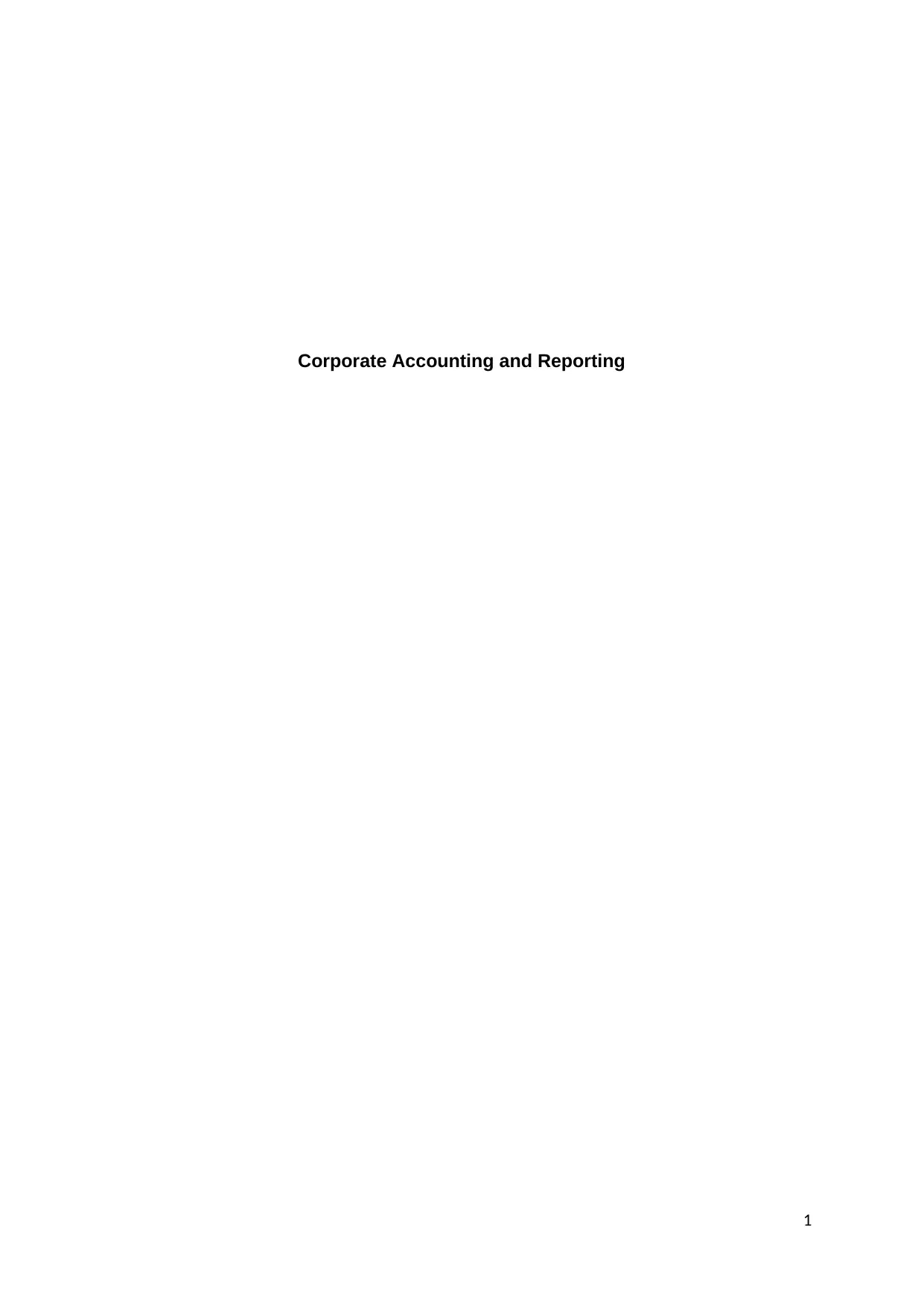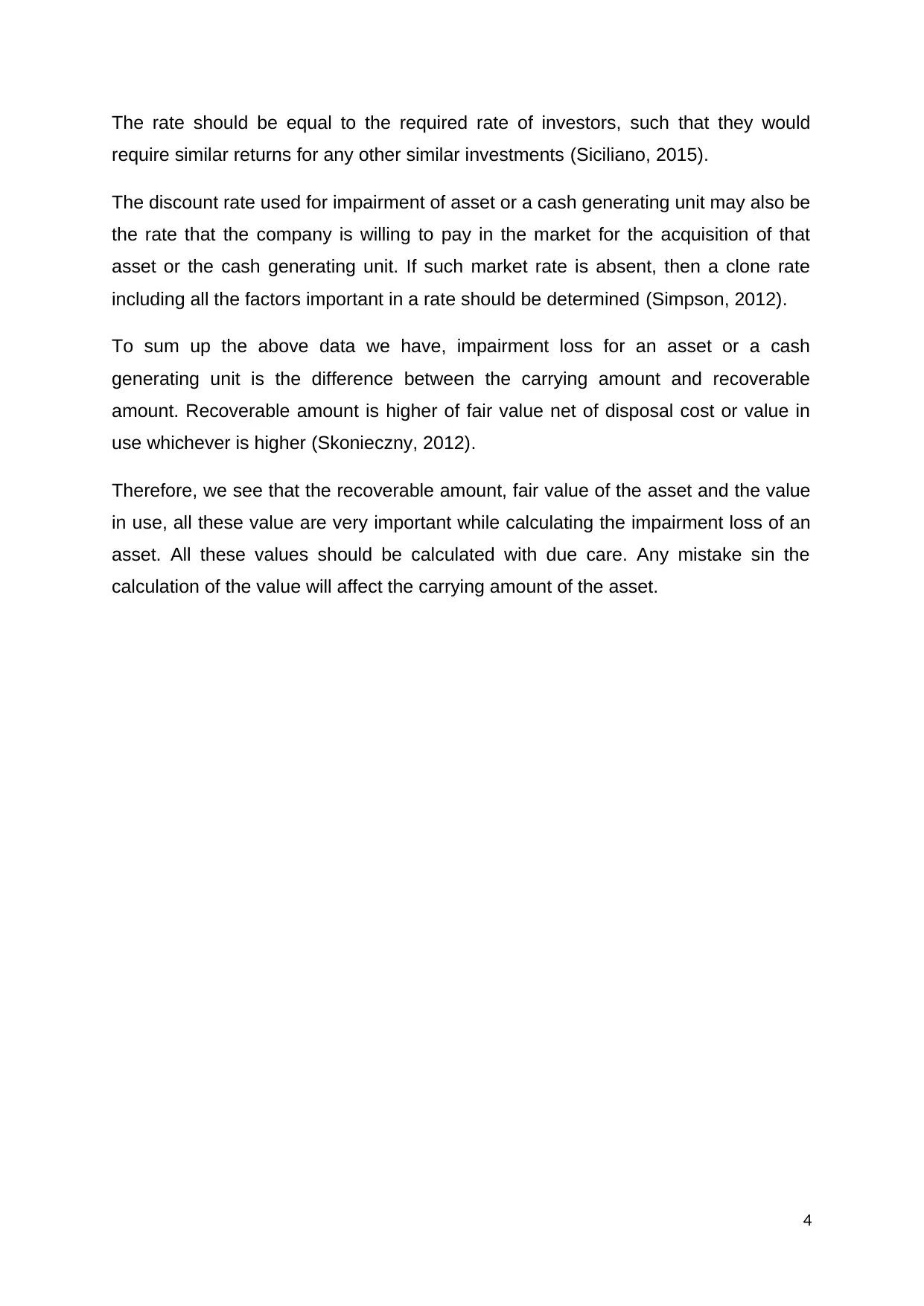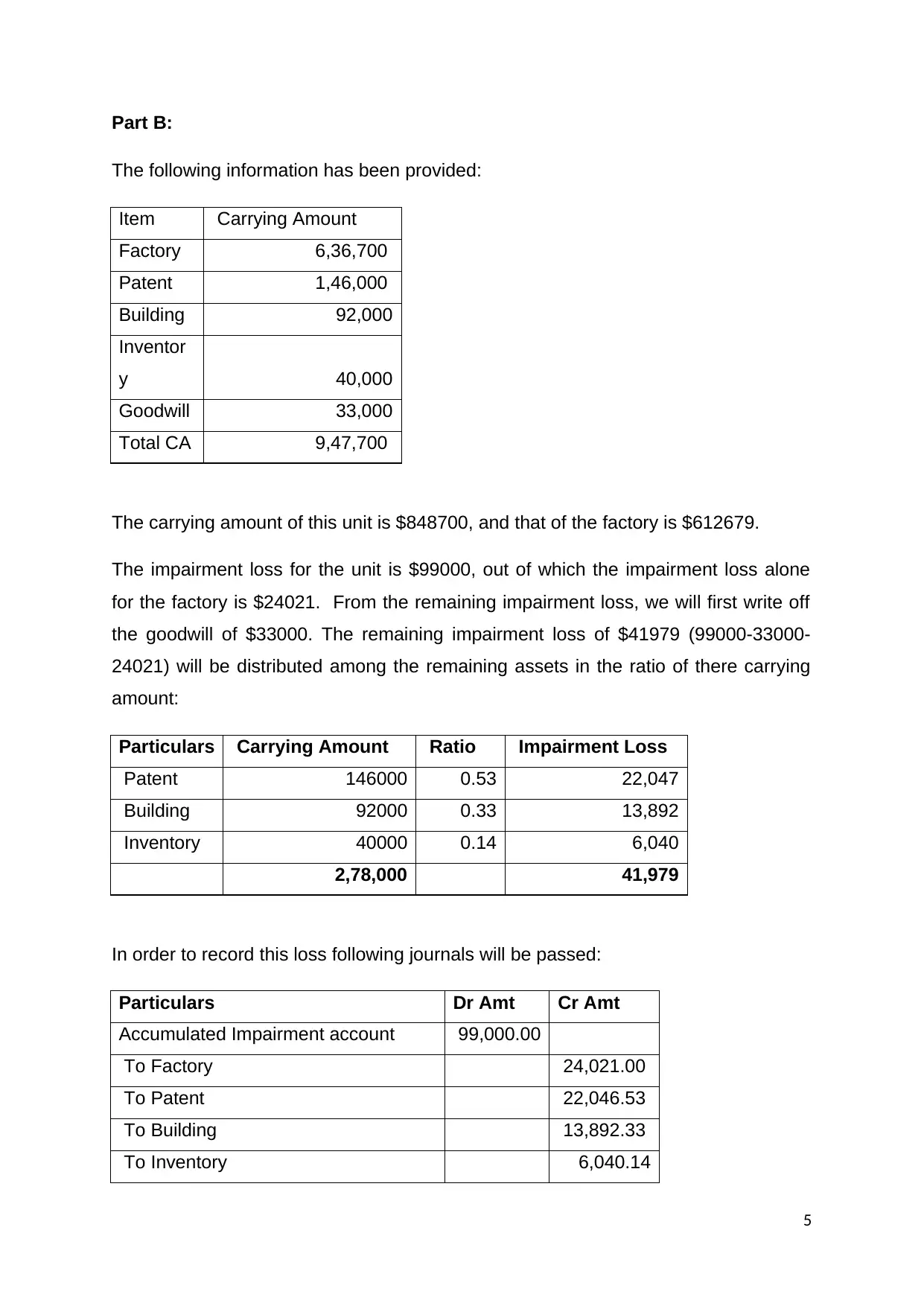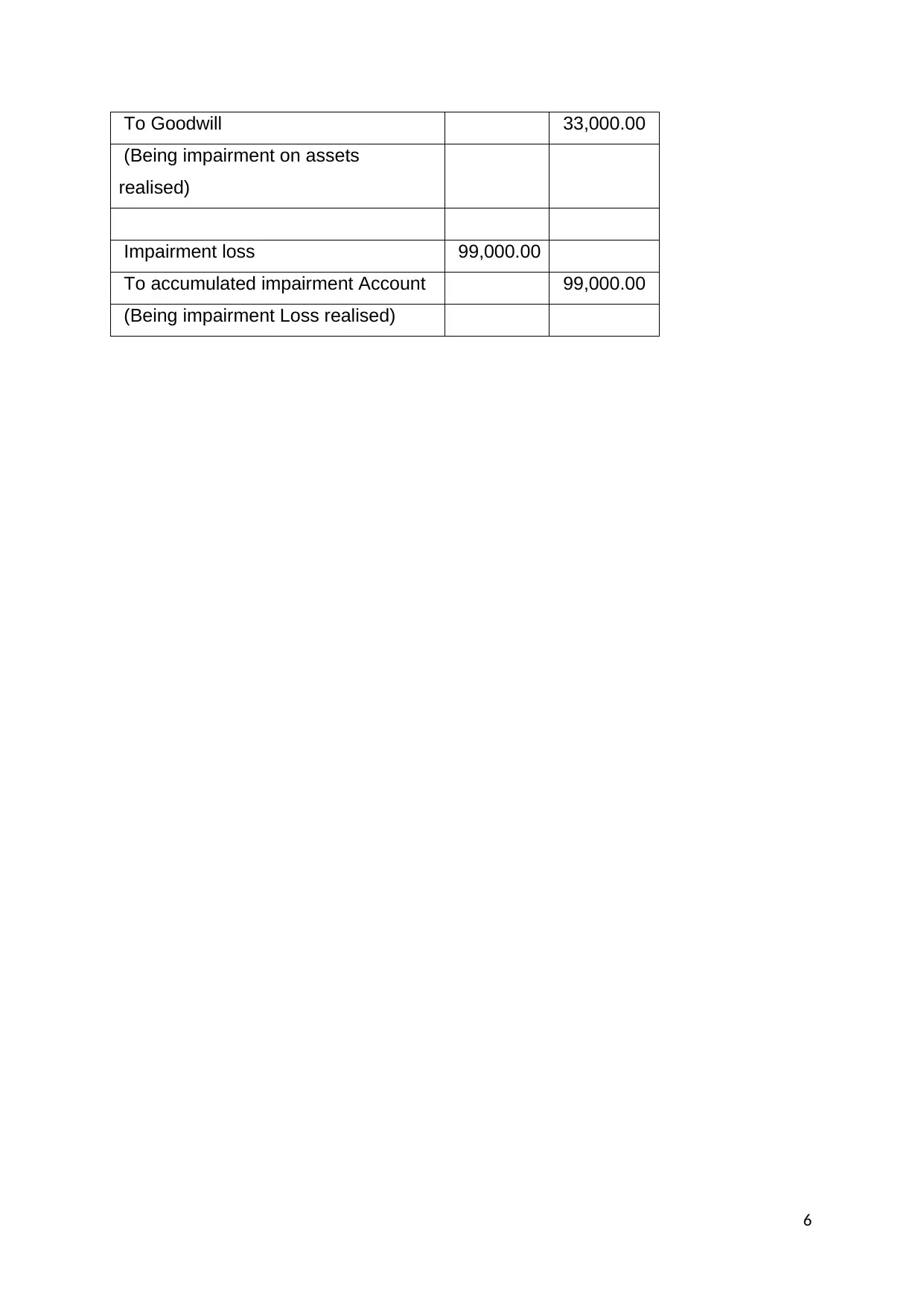Corporate Accounting and Reporting 1 Assignment: Impairment
VerifiedAdded on 2023/06/07
|7
|1417
|176
Homework Assignment
AI Summary
This assignment solution addresses a corporate accounting assignment focusing on asset impairment. Part A provides a detailed explanation of impairment testing, emphasizing the calculation of recoverable amount, fair value less cost of disposal, and value in use. It explains the conditions under which impairment occurs and the accounting treatments required. Part B presents a practical application of the theory, including a case study of Gali Ltd's fine china division, treated as a cash-generating unit (CGU). It includes all the required calculations, such as the determination of the impairment loss for each asset, and the subsequent journal entries to record the impairment loss for the factory, patent, building, inventory and goodwill. The solution references several accounting standards and academic sources to support its analysis.

Corporate Accounting and Reporting
1
1
Paraphrase This Document
Need a fresh take? Get an instant paraphrase of this document with our AI Paraphraser

Part A:
In order to present the assets in the true and fair view, the companies are required to
carry out the impairment test of the assets. In this test it is checked if the assets are
being carried at amounts which is not more than its recoverable amount. The
companies are required to check for impairment of goodwill and other intangible
assets on an annual basis (Alvarez, 2013). They are also required to check if
conditions for impairment of other assets exist. An asset is said to be impaired when
its recoverable amount falls below the carrying amount. In such cases the
companies are required to account for the impairment loss and record the assets in
the book at the revised values. When the asset is not individually capable of
generating cash flows, then impairment test for the cash generating unit should be
done (Australian Accounting Standards Board).
Calculation of impairment loss requires collection of some financial data. The
management needs to know the recoverable amount of the asset in order to
compare it with the carrying amount of the assets. Where there are assets which for
a part of cash generating unit, then the values for such cash generating units are to
be calculated (Elaine, 2015).
Recoverable amount refers to the amount that the company would receive if the
asset is sold in the market at the time of impairment test. Any selling expenses which
are to be incurred in connection with the sale of the asset are to be deducted from
the recoverable amount (Girard, 2014).
If the recoverable amount of an individual asset cannot be determined then the
recoverable amount of the whole cash generating unit should be calculated (Parrino,
2013).
Following should be taken into consideration in order to determine the recoverable
amount of the asset being tested for impairment:
- If carrying amount of the asset is less than the fair value net of disposal costs or
value in use, then calculating recoverable amount is unnecessary as the asset is
not impaired
- If the fair value net of disposal cost cannot be determined, then we use the value
in use as the recoverable amount
2
In order to present the assets in the true and fair view, the companies are required to
carry out the impairment test of the assets. In this test it is checked if the assets are
being carried at amounts which is not more than its recoverable amount. The
companies are required to check for impairment of goodwill and other intangible
assets on an annual basis (Alvarez, 2013). They are also required to check if
conditions for impairment of other assets exist. An asset is said to be impaired when
its recoverable amount falls below the carrying amount. In such cases the
companies are required to account for the impairment loss and record the assets in
the book at the revised values. When the asset is not individually capable of
generating cash flows, then impairment test for the cash generating unit should be
done (Australian Accounting Standards Board).
Calculation of impairment loss requires collection of some financial data. The
management needs to know the recoverable amount of the asset in order to
compare it with the carrying amount of the assets. Where there are assets which for
a part of cash generating unit, then the values for such cash generating units are to
be calculated (Elaine, 2015).
Recoverable amount refers to the amount that the company would receive if the
asset is sold in the market at the time of impairment test. Any selling expenses which
are to be incurred in connection with the sale of the asset are to be deducted from
the recoverable amount (Girard, 2014).
If the recoverable amount of an individual asset cannot be determined then the
recoverable amount of the whole cash generating unit should be calculated (Parrino,
2013).
Following should be taken into consideration in order to determine the recoverable
amount of the asset being tested for impairment:
- If carrying amount of the asset is less than the fair value net of disposal costs or
value in use, then calculating recoverable amount is unnecessary as the asset is
not impaired
- If the fair value net of disposal cost cannot be determined, then we use the value
in use as the recoverable amount
2

- For the assets which are required to be sold, then for such assets recoverable
amount is fair value net of disposal costs.
In order to determine the fair value of the asset to check for its impairment, the
company is required to hire a certified valuer. Only such persons can determine the
fair value of an asset. The fair value is to be calculated taking into considerations the
guidelines laid down for fair value measurements of the assets. While considering
the fair value of the asset any costs which might be incurred at the disposal of the
asset should be subtracted in to determine the net fair value (Penman, 2012).
Value in use of the assets is one of the most complicated values which are required
to be calculated in order to account for impairment. The following should be included
while evaluating the value in use of the asset:
- The discounted values of the future cash flows that are expected to be generated
from the assets. While calculating these cash flows the factors which might affect
them should also be taken into consideration. The discount rate to be chosen for
discounting should be based on lot of research and facts (Taillard, 2013).
- The projections of the expected cash flows mentioned above should be based on
reasonable and suitable assumptions. The budgets and the forecasts of the most
recent years. The budgets should be considered for a period of five years only, in
order to account for the budgets beyond five years the company should follow
the past trends the budgets. They should also access the reasons for variations
between the budgeted and actual cash flows.
- The calculations of the cash flows should be based on the current condition of
the asset. Any future changes or restructuring which are being planned or might
be implemented should not be taken into consideration why evaluating the
current condition of the asset.
The discount rate that is to be chosen for discounting should be a pre tax rate that
reflects the time value of money. Such discounting rate should also include the risk
factors associated with the asset.
The risk factors included while calculating the cash flows should not be included in
the discount rate, or else these factors would be included twice in the calculations.
3
amount is fair value net of disposal costs.
In order to determine the fair value of the asset to check for its impairment, the
company is required to hire a certified valuer. Only such persons can determine the
fair value of an asset. The fair value is to be calculated taking into considerations the
guidelines laid down for fair value measurements of the assets. While considering
the fair value of the asset any costs which might be incurred at the disposal of the
asset should be subtracted in to determine the net fair value (Penman, 2012).
Value in use of the assets is one of the most complicated values which are required
to be calculated in order to account for impairment. The following should be included
while evaluating the value in use of the asset:
- The discounted values of the future cash flows that are expected to be generated
from the assets. While calculating these cash flows the factors which might affect
them should also be taken into consideration. The discount rate to be chosen for
discounting should be based on lot of research and facts (Taillard, 2013).
- The projections of the expected cash flows mentioned above should be based on
reasonable and suitable assumptions. The budgets and the forecasts of the most
recent years. The budgets should be considered for a period of five years only, in
order to account for the budgets beyond five years the company should follow
the past trends the budgets. They should also access the reasons for variations
between the budgeted and actual cash flows.
- The calculations of the cash flows should be based on the current condition of
the asset. Any future changes or restructuring which are being planned or might
be implemented should not be taken into consideration why evaluating the
current condition of the asset.
The discount rate that is to be chosen for discounting should be a pre tax rate that
reflects the time value of money. Such discounting rate should also include the risk
factors associated with the asset.
The risk factors included while calculating the cash flows should not be included in
the discount rate, or else these factors would be included twice in the calculations.
3
⊘ This is a preview!⊘
Do you want full access?
Subscribe today to unlock all pages.

Trusted by 1+ million students worldwide

The rate should be equal to the required rate of investors, such that they would
require similar returns for any other similar investments (Siciliano, 2015).
The discount rate used for impairment of asset or a cash generating unit may also be
the rate that the company is willing to pay in the market for the acquisition of that
asset or the cash generating unit. If such market rate is absent, then a clone rate
including all the factors important in a rate should be determined (Simpson, 2012).
To sum up the above data we have, impairment loss for an asset or a cash
generating unit is the difference between the carrying amount and recoverable
amount. Recoverable amount is higher of fair value net of disposal cost or value in
use whichever is higher (Skonieczny, 2012).
Therefore, we see that the recoverable amount, fair value of the asset and the value
in use, all these value are very important while calculating the impairment loss of an
asset. All these values should be calculated with due care. Any mistake sin the
calculation of the value will affect the carrying amount of the asset.
4
require similar returns for any other similar investments (Siciliano, 2015).
The discount rate used for impairment of asset or a cash generating unit may also be
the rate that the company is willing to pay in the market for the acquisition of that
asset or the cash generating unit. If such market rate is absent, then a clone rate
including all the factors important in a rate should be determined (Simpson, 2012).
To sum up the above data we have, impairment loss for an asset or a cash
generating unit is the difference between the carrying amount and recoverable
amount. Recoverable amount is higher of fair value net of disposal cost or value in
use whichever is higher (Skonieczny, 2012).
Therefore, we see that the recoverable amount, fair value of the asset and the value
in use, all these value are very important while calculating the impairment loss of an
asset. All these values should be calculated with due care. Any mistake sin the
calculation of the value will affect the carrying amount of the asset.
4
Paraphrase This Document
Need a fresh take? Get an instant paraphrase of this document with our AI Paraphraser

Part B:
The following information has been provided:
Item Carrying Amount
Factory 6,36,700
Patent 1,46,000
Building 92,000
Inventor
y 40,000
Goodwill 33,000
Total CA 9,47,700
The carrying amount of this unit is $848700, and that of the factory is $612679.
The impairment loss for the unit is $99000, out of which the impairment loss alone
for the factory is $24021. From the remaining impairment loss, we will first write off
the goodwill of $33000. The remaining impairment loss of $41979 (99000-33000-
24021) will be distributed among the remaining assets in the ratio of there carrying
amount:
Particulars Carrying Amount Ratio Impairment Loss
Patent 146000 0.53 22,047
Building 92000 0.33 13,892
Inventory 40000 0.14 6,040
2,78,000 41,979
In order to record this loss following journals will be passed:
Particulars Dr Amt Cr Amt
Accumulated Impairment account 99,000.00
To Factory 24,021.00
To Patent 22,046.53
To Building 13,892.33
To Inventory 6,040.14
5
The following information has been provided:
Item Carrying Amount
Factory 6,36,700
Patent 1,46,000
Building 92,000
Inventor
y 40,000
Goodwill 33,000
Total CA 9,47,700
The carrying amount of this unit is $848700, and that of the factory is $612679.
The impairment loss for the unit is $99000, out of which the impairment loss alone
for the factory is $24021. From the remaining impairment loss, we will first write off
the goodwill of $33000. The remaining impairment loss of $41979 (99000-33000-
24021) will be distributed among the remaining assets in the ratio of there carrying
amount:
Particulars Carrying Amount Ratio Impairment Loss
Patent 146000 0.53 22,047
Building 92000 0.33 13,892
Inventory 40000 0.14 6,040
2,78,000 41,979
In order to record this loss following journals will be passed:
Particulars Dr Amt Cr Amt
Accumulated Impairment account 99,000.00
To Factory 24,021.00
To Patent 22,046.53
To Building 13,892.33
To Inventory 6,040.14
5

To Goodwill 33,000.00
(Being impairment on assets
realised)
Impairment loss 99,000.00
To accumulated impairment Account 99,000.00
(Being impairment Loss realised)
6
(Being impairment on assets
realised)
Impairment loss 99,000.00
To accumulated impairment Account 99,000.00
(Being impairment Loss realised)
6
⊘ This is a preview!⊘
Do you want full access?
Subscribe today to unlock all pages.

Trusted by 1+ million students worldwide

Bibliography
Alvarez, F. (2013). Financial statement analysis. Hoboken, N.J.: Wiley.
Australian Accounting Standards Board. (n.d.). Impairment of Assets. Retrieved from
www.aasb.gov.au: https://www.aasb.gov.au/admin/file/content105/c9/AASB136_07-
04_COMPjun09_01-10.pdf
Elaine, H. (2015). International financial statement analysis. Hoboken: John Wiley &
Sons.
Girard, S. L. (2014). Business finance basics. Pompton Plains, NJ: Career Press.
Parrino, R. (2013). Fundamentals of Corporate Finance, 2nd Edition. Milton: John
Wiley & Sons.
Penman, S. (2012). Financial statement analysis and security valuation. Boston,
Mass.: McGraw-Hill.
Siciliano, G. (2015). Finance for Nonfinancial Managers. New York: McGraw-Hill.
Simpson, M. (2012). Financial accounting. Basingstoke: Macmillan Press.
Skonieczny, M. (2012). The basics of understanding financial statements.
Schaumburg, Ill.: Investment Publishing.
Taillard, M. (2013). Corporate finance for dummies. Hoboken, N.J.: Wiley.
7
Alvarez, F. (2013). Financial statement analysis. Hoboken, N.J.: Wiley.
Australian Accounting Standards Board. (n.d.). Impairment of Assets. Retrieved from
www.aasb.gov.au: https://www.aasb.gov.au/admin/file/content105/c9/AASB136_07-
04_COMPjun09_01-10.pdf
Elaine, H. (2015). International financial statement analysis. Hoboken: John Wiley &
Sons.
Girard, S. L. (2014). Business finance basics. Pompton Plains, NJ: Career Press.
Parrino, R. (2013). Fundamentals of Corporate Finance, 2nd Edition. Milton: John
Wiley & Sons.
Penman, S. (2012). Financial statement analysis and security valuation. Boston,
Mass.: McGraw-Hill.
Siciliano, G. (2015). Finance for Nonfinancial Managers. New York: McGraw-Hill.
Simpson, M. (2012). Financial accounting. Basingstoke: Macmillan Press.
Skonieczny, M. (2012). The basics of understanding financial statements.
Schaumburg, Ill.: Investment Publishing.
Taillard, M. (2013). Corporate finance for dummies. Hoboken, N.J.: Wiley.
7
1 out of 7
Related Documents
Your All-in-One AI-Powered Toolkit for Academic Success.
+13062052269
info@desklib.com
Available 24*7 on WhatsApp / Email
![[object Object]](/_next/static/media/star-bottom.7253800d.svg)
Unlock your academic potential
Copyright © 2020–2025 A2Z Services. All Rights Reserved. Developed and managed by ZUCOL.




